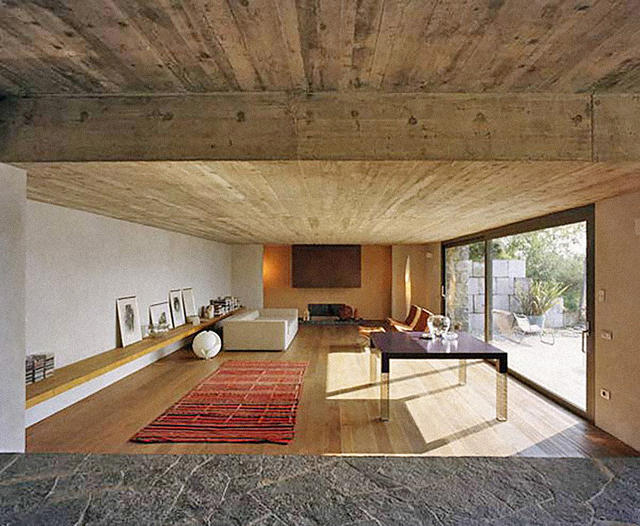Why Our Brains Love high Ceilings
not just for bragging rights.
March 5, 2015
one of the most first issues a realtor will level out to prospective house consumers or condo tenants is a high ceiling. To many of us, anything above the usual eight-foot ceiling is a huge promoting level. In contemporary occasions, dwelling buyers have tended to pony up for the amenity of nine-foot ceilings; within the summary, when delivered heights aren’t adding to mortgages or rents, people choose their ceilings 10 ft excessive.
a part of the appeal of high ceilings is unquestionably associated to a general preference for space, however the behavioral and brain evidence suggests there is extra to it than that. a little analysis from a number of years back ties excessive ceilings to a psychological sense of freedom. And new neuroimaging work displays that a tall room triggers our tendencies toward spatial exploration.
“that you can imagine that our enjoyment of rooms with greater ceilings can be because of these two techniques working in tandem,” psychologist Oshin Vartanian of the university of Toronto-Scarborough tells Co. Design. “On the one hand, such rooms promote visuospatial exploration, while on the related time they steered us to suppose more freely. This is usually a slightly powerful combination for inducing positive emotions.”
A Liberated mindset
a number of years in the past, advertising students Joan Meyers-Levy and Rui Zhu needed to look whether the peak of a ceiling had any affect on the way in which a person thinks. so that they recruited test individuals for plenty of completely different experiments and modified the classrooms so that some had 10-foot ceilings and others had (false) eight-foot ceilings. Meyers-Levy and Zhu also hung up chinese lanterns so participants would search for and, consciously or now not, process the ceiling height.

across a couple of experiments, the researchers discovered evidence that prime ceilings seemed to put check individuals in a mindset of freedom, creativity, and abstraction, whereas the decrease ceilings prompting more constrained considering.
in a single check, for example, members in the 10-foot room achieved anagrams about freedom (with phrases comparable to “liberated” or “unlimited”) significantly quicker than individuals within the eight-foot room did. however when the anagrams were associated to concepts of constraint, with words like “certain or “limited,” the location performed out in reverse. Now the take a look at individuals with 10-foot ceilings finished the puzzles slower than those in the eight-foot rooms did.
any other experiment requested contributors to identify commonalities among a listing of 10 completely different sports. these within the high-ceiling team got here up with more of those themes, and had their subject matters judged extra abstract in nature, compared with participants within the low-ceiling team. Meyers-Levy and Zhu suspect this result emerged from the psychological freedom that includes taller ceilings—a mind-set that may additionally beef up ingenious thinking.
Altogether, they conclude in a 2007 issue of the Journal of shopper analysis, the analysis “presentations that, via activating freedom-associated or confinement-related ideas, ceiling height will also be an antecedent of form of processing.”
Ceiling brain Scans
the brand new neuroscience study, led via Vartanian, had take a look at individuals look at 200 pictures of rooms whereas in a brain scanner. half of the images showed rooms with high ceilings, 1/2 with low (below). members had a very simple job: point out whether or not they considered the room “beautiful” or “no longer gorgeous.” (the information in reality came from an past find out about that looked at why our brains like curvy structure, but had been reanalyzed through the lens of ceiling top.)

Little shock, members had been more prone to judge a room gorgeous if it had a excessive ceiling in comparison with a low ceiling. but the larger perception emerged when Vartanian and collaborators studied mind activity. They found heightened job related to high ceilings within the left precuneus and left center frontal gyrus—two areas associated with visuospatial exploration. The left precuneus, in particular, has been found to extend in cortical thickness after spatial navigation training.
So some other a part of the enchantment of excessive ceilings seems to be that they capture our visual consideration and have interaction our want to observe our surroundings. Vartanian and company ruled out different explanations in response to the imaging information, including the likelihood that prime ceilings merely put us in a good temper. that idea did not pan out as a result of participants taking a look at high and low ceilings confirmed no fMRI distinction in mind regions related to pleasure, emotion, or reward.
The findings, mentioned in a recent difficulty of the Journal of Environmental Psychology, should be thought to be preliminary given the learn about’s boundaries. For one factor, the check couldn’t control for factors in addition to ceiling peak that may have resulted in “gorgeous” rankings, such as the lighting or coloration scheme or curved design. And, of course, people weren’t bodily standing in a room with high ceilings, which might change the experience.

however Vartanian says the research—together with the earlier work linking ceiling height and freedom—does add to our working out of why individuals find excessive ceilings useful of an actual-estate top class.
“the mix of psychological and neural data can assist us formulate a more full image of what’s using our picks,” he says. “knowing that people’s choice for rooms with greater ceilings might be driven by way of the ability of those spaces to promote visuospatial exploration helps partly provide an explanation for why individuals choose to are living in such spaces, even supposing they cost more to purchase and care for.”
quick company , read Full Story
(108)













